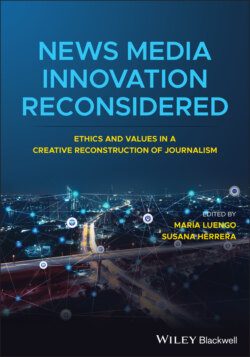Читать книгу News Media Innovation Reconsidered - Группа авторов - Страница 30
Engaged and Disengaged
ОглавлениеOur default psychological approach to the world is to be engaged with it in some manner. The etymology of “engagement” revolves around three senses: being occupied with something; being committed to something; and finding something interesting. We are occupied when we perform a role or job. Teachers are engaged in classrooms. Being occupied can also mean being engrossed in some activity, e.g., learning to paint watercolors. Engagement is commitment when we pursue some complex, usually difficult to reach, goal, e.g., to commit oneself to marriage, or to devote one’s life to helping street people. One is occupied and committed. We are engaged with something as entertaining when something grabs our attention, such as an engaging play. For this chapter, engaged means being occupied with, and committed to, social goals or practices.
To be disengaged means not to be occupied, committed, or fully involved with the world or some aspect of the world. This disengagement can take on two forms: global and local.
Global disengagement occurs when a person withdraws from agency and society, often caused by a decline in interest in the world. Seriously depressed people experience a nihilism of values, and can lose interest in the issues that roil social life. Some people, depressed or not, may become an ironic spectator on life’s passing show, or become a hermit. There is also local disengagement which means that a person is not engaged in this issue, or that activity, or these groups, at this time.
Aside from depression or a lack of interest, what other reasons might there be to adopt the attitude of disengagement? One reason is to set aside the pressures of life, temporarily, to do intellectual work, e.g., to retreat to my study to create a theory. Another reason is to ensure rigorous, critical inquiry. This is the motive behind the many objective methods of scientific and humanistic inquiry into nature or society. Disengagement means standing back from beliefs and goals, the better to judge them. This same call for disengagement occurs in the professions, where judges, teachers, and public servants are cautioned to make objective judgments based on facts and logic, without the influence of conflicts of interest.
As noted, journalistic disengagement in the early 1900s came to be called news objectivity. To be disengaged meant the reporter should place a distance between themselves and their biases and beliefs. They do not use reporting to advance their personal interests. They maintain intellectual and editorial independence from the world outside—audiences, advertisers, donors, and political pressure groups. They are neutral and report just the facts.
Engaged journalism is defined in contrast to disengaged journalism. It is not neutral and its reports include “more” than the facts, such as interpretation, opinion, advocacy, or polemical argument. Moreover, it does not place a “wall” of independence between journalists and external groups. Some forms of engaged journalism think journalists should get closer to public groups, the better to understand their needs or causes.
Where does engaged journalism fit with respect to other forms of journalism? There are many ways to categorize journalisms: by form of technology (e.g., broadcasting, online, print newspaper), by size (global, national, or local news media), by their political perspective (liberal, conservative, anarchist, far-right), or by their types of audiences (young, rural, urban, college-educated). No category system is uniquely correct or best. It depends on your purpose.
Figure 2.1 ranges from the strongly disengaged and neutral pole to the strongly engaged pole. The continuum contains three broad categories of journalism.
Figure 2.1 A Continuum of Engagement.
Disengaged journalism: The goal is factual and fair informing, without taking a position or a strong perspective, without engaging in persuasive rhetoric or seeking to participate with citizens in some social project. The most obvious example is neutral reporting already discussed. But it is not limited to neutral reporting. It is possible to include explanatory journalism, such as found in science journalism, in thoughtful, non-polemical analyses of issues, or in “backgrounders” on complex public events. “Explainers” and analysis do depart from strict neutrality but they belong to the disengaged category because they tend to stay close to the facts, they attempt to represent views fairly, and they are moderate in opinion or persuasive rhetoric.
Perspectival engaged journalism: The goal is to influence public opinion, and perhaps encourage social reform, by expressing through publication certain opinions, perspectives, and arguments. A newspaper’s editorial or the opinion of a newspaper columnist are traditional examples. Investigative journalism belongs here because it rejects neutrality, while seeking deep facts below the level of press releases and political rhetoric. Interpretive journalism is found in attempts by foreign reporters to give “meaning” to complicated movements, and in magazines such as The New Yorker, and The Economist, which mix reportage and commentary. Also included are stronger forms of perspectival journalism, such as advocacy and activist journalism, and the websites of partisan or ideological groups whose writings can stray into the realm of propaganda. In this category, journalists abandon neutrality as an ideal, and they honor norms such as accuracy and fairness in varying degrees.
Active engaged journalism: The goal is not only to express views and hope they have an impact, but to act socially and politically in the public sphere. Journalism in this category departs the most from the ideals of disengaged journalism. The kinds of journalism include: (a) extreme populist groups that seek to recruit citizens to their perspective and political causes, or to vote for their leaders. This may include encouraging citizens to show up at rallies by their leaders, or to disrupt the public events of their political “enemies;” (b) participatory journalism which uses the Internet and social media to gather news, images, and eye-witness testimony from citizens around the world; and (c) civic engagement journalism where journalists encourage community activism in the hope of improving communities.
